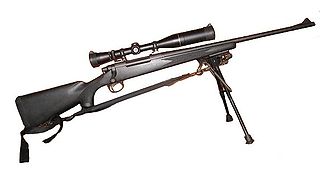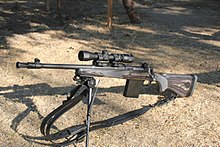The scout rifle is a conceptual class of general-purpose rifles defined and promoted by Jeff Cooper in the early 1980s that bears similarities in the design and functionality of guide guns, mountain rifles, and other rifle archetypes, but with more emphasis being placed on comfortable portability and practical accuracy, rather than firepower and long range shooting.
Savage Arms is an American gunmaker based in Westfield, Massachusetts, with operations in Canada and China, PRC. Savage makes a variety of rimfire and centerfire rifles, as well as Stevens single-shot rifles and shotguns. The company is best known for the Model 99 lever-action rifle, no longer in production, and the .300 Savage. Savage was a subsidiary of Vista Outdoor until 2019 when it was spun off.
The Ruger 10/22 is a series of semi-automatic rifles produced by American firearm manufacturer Sturm, Ruger & Co., chambered for the .22 Long Rifle rimfire cartridge. It uses a patented 10-round rotary magazine, though higher capacity box magazines are also available. The standard carbine version of the Ruger 10/22 has been in production continuously since 1964, making it one of the most successful rimfire rifle designs in history, with numerous third party manufacturers making parts and accessories for upgrading and customization. The 10/22's aftermarket is so prolific that a complete 10/22 can be built without using any Ruger-made components.

The Remington Model 700 is a series of bolt-action centerfire rifles manufactured by Remington Arms since 1962. It is a development of the Remington 721 and 722 series of rifles, which were introduced in 1948. The M24 and M40 military sniper rifles, used by the US Army and Marine Corps, respectively, are both based on the Model 700 design.
The Winchester Model 70 is a bolt-action sporting rifle. It has an iconic place in American sporting culture and has been held in high regard by shooters since it was introduced in 1936, earning the moniker "The Rifleman's Rifle". The action has some design similarities to Mauser designs and it is a development of the earlier Winchester Model 54, itself being based on a Mauser 98–type action.
The Marlin Model 336 is a lever-action rifle and carbine made by Marlin Firearms. Since its introduction in 1948, it has been offered in a number of different calibers and barrel lengths, but is commonly chambered in .30-30 Winchester or .35 Remington, using a 20- or 24-inch barrel. Currently, the model with a 24-inch barrel is only available in .30-30 Winchester. The Model 336 is now back in production as of March 27, 2023.
The Sako TRG is a bolt-action sniper rifle line designed and manufactured by Finnish firearms manufacturer SAKO of Riihimäki. It is the successor to the SAKO TR-6 target rifle, and thus the letter G within the rifle's name is meant to represent number 7.
The Savage Model 110 is a bolt-action repeating rifle made by Savage Arms. It was designed in 1958 by Nicholas L. Brewer. It was patented in 1963. The Model 110 has been in continuous production since that time.
The Remington Model 798 is a bolt-action rifle that was sold by Remington Arms from 2006 until 2008. The gun was made as a hunting rifle. It is composed of an imported Zastava Arms barreled action assembled with a laminated stock after import to the United States. It is based on a Mauser 98 action. It is chambered for .243 Winchester, .308 Winchester, .30-06 Springfield, .270 Winchester, 7mm Remington.Magnum, .300 Winchester.Magnum, .375 H&H Magnum and .458 Winchester Magnum It is drilled and tapped for scope mounts. It can have a barrel length of 22, 24 or 26 inches. It weighs 7 pounds, and has a brown laminated stock. The standard variant costs $599, and the Magnum versions can cost anything between $638 and $839. This is an all-steel, controlled-feed action using a flat-bottom receiver with an integral recoil lug, one-piece bolt with dual locking lugs plus a third safety lug and a bolt guide, full-length extractor, solid steel one-piece bottom iron/magazine box/trigger guard, hinged magazine floor plate, and all of the usual Mauser 98 deluxe features.
The .375 Ruger (9.5×65.5mm) is a rimless, standard-length rifle cartridge designed for hunting large, dangerous game. It is designed to provide an increase in performance over the .375 H&H cartridge within the context of a standard-length rifle action. The cartridge was designed in partnership by Hornady and Ruger. In 2007, it was released commercially and chambered in the Ruger Hawkeye African and the Ruger Hawkeye Alaskan rifles.
The Winchester Model 52 was a bolt-action .22-caliber target rifle introduced by the Winchester Repeating Arms Company in 1920. For many years it was the premier smallbore match rifle in the United States, if not the world. Known as the "King of the .22s," the Model 52 Sporter was ranked by Field & Stream as one of "the 50 best guns ever made" and described by Winchester historian Herbert Houze as "perfection in design." However, by the 1970s the World War I-era design was showing its age and had given way in top-level competition to newer match rifles from Walther and Anschütz; the costly-to-produce Model 52, which had long been a loss leader prestige product by that time, was finally discontinued when US Repeating Arms took over the manufacture of Winchester rifles from Olin Corporation in 1980.
The CZ-550 is a bolt-action hunting rifle series manufactured by Česká zbrojovka Uherský Brod. The CZ 550 series is available with a medium or magnum sized action. The CZ 550 rifle is based on the Mauser 98 rifle.
The Mauser M 98 are a series of currently (2020) produced bolt-action hunting rifles. The production of the controlled round feed Mauser 98 bolt action system for the German military ceased at the end of World War II in 1945. The new Mauser M 98 and M 98 Magnum rifles for civil users are in production since 1999 in Isny im Allgäu, Germany by Mauser Jagdwaffen GmbH, according to original drawings of 1936 and the respective Mauser patents. Mauser Jagdwaffen GmbH is a subsidiary of SIG Sauer.
The Howa 1500 or Howa M1500 is a bolt-action rifle produced in Japan by Howa Machinery. Introduced in 1979, it has been used by hunters as a hunting rifle with various cartridge offerings. It is also utilized by military and law enforcement elements as a sniper rifle. It is sold under the name of Howa Model 1500 Rifle for overseas markets.

The Blaser R8 is a German straight-pull rifle known for its radially locking bolt system, modularity and its barrel mounted scope mount manufactured by Blaser. The rifle also features a manual cocking system and a direct trigger. In 2015 there had been more than 100,000 complete Blaser R8 rifles produced.
The Ruger American Rifle is a family of budget-level hunting/sporting bolt-action centerfire rifle made by Sturm, Ruger & Co., which also produces a line of rimfire rifles with similar designs called the Ruger American Rimfire.
The BSA CF2 is a rifle manufactured by the Birmingham Small Arms Company (BSA).
The Model 721 and Model 722 along with the later Model 725 variant are bolt-action sporting rifles manufactured by Remington Arms from 1948 until 1961. The 721/722 replaced the short-lived Model 720. The Model 721/722 is considered to be one of the first modern, economically produced sporting rifles whose design largely continued with the subsequent and highly successful Model 700. Manufactured with high precision, it is known for exceptional accuracy. The bolt and receiver design, based on the Mauser action, is considered one of the strongest ever produced. Samples in excellent condition have become collectible.
The .338 Ruger Compact Magnum or .338 RCM is a rimless, short-length rifle cartridge based on the .375 Ruger case. Sturm Ruger and Hornady jointly developed the round, which was released in 2008 and chambered in various Ruger rifles. The goal of the project was to produce a .338 caliber cartridge with magnum level performance that would fit in a compact, short action rifle. The .338 RCM is conceptually similar to the WSM cartridge family, but is somewhat smaller dimensionally. This often allows for a higher magazine capacity than the WSM equivalent. Like the .338 caliber cartridges which predated it, the round is designed for hunting medium to large sized North American game.

Push feed and controlled feed are two main types of mechanisms used in firearms to describe how the bolt drives the cartridge into the chamber and extracts the spent casing after firing.





